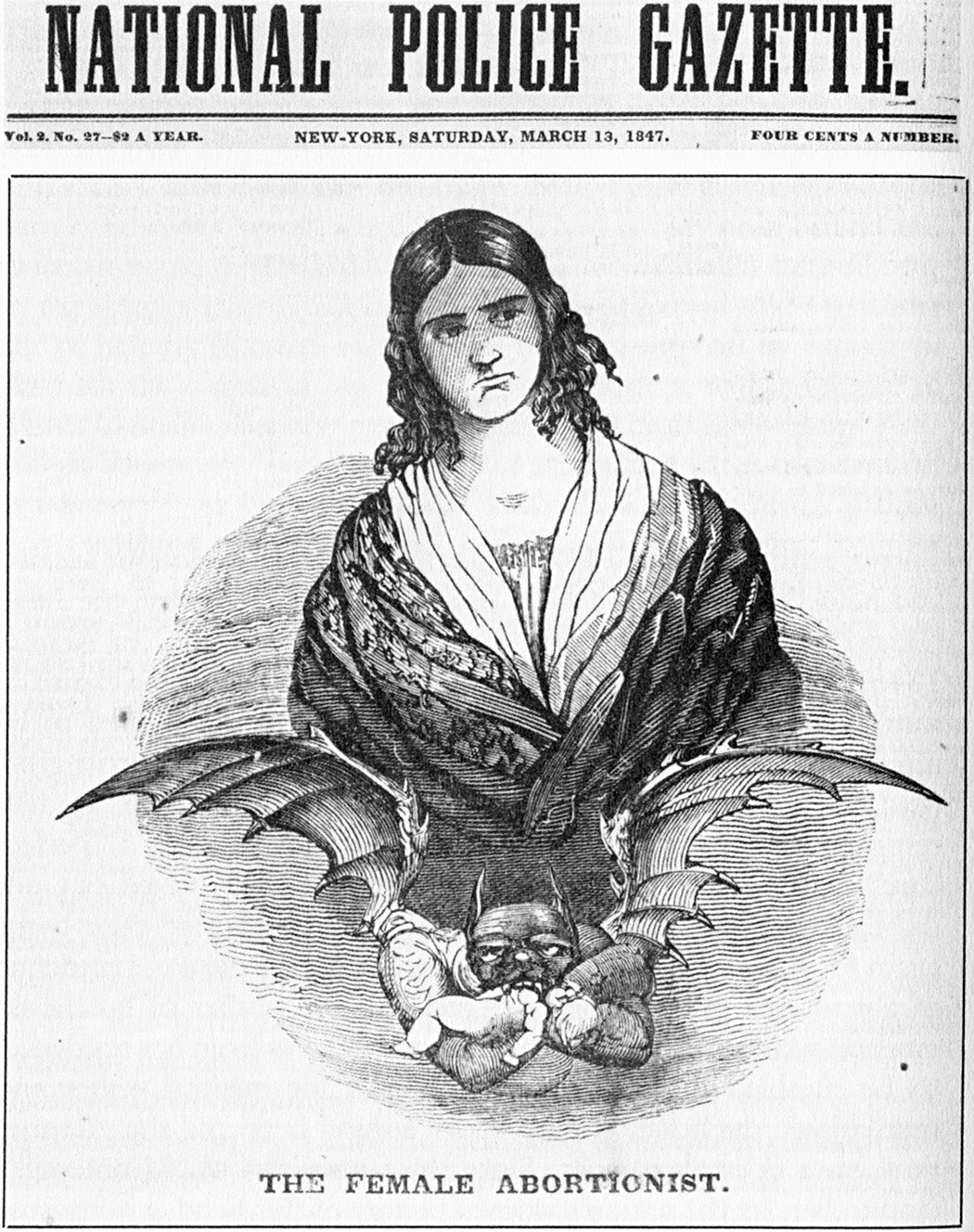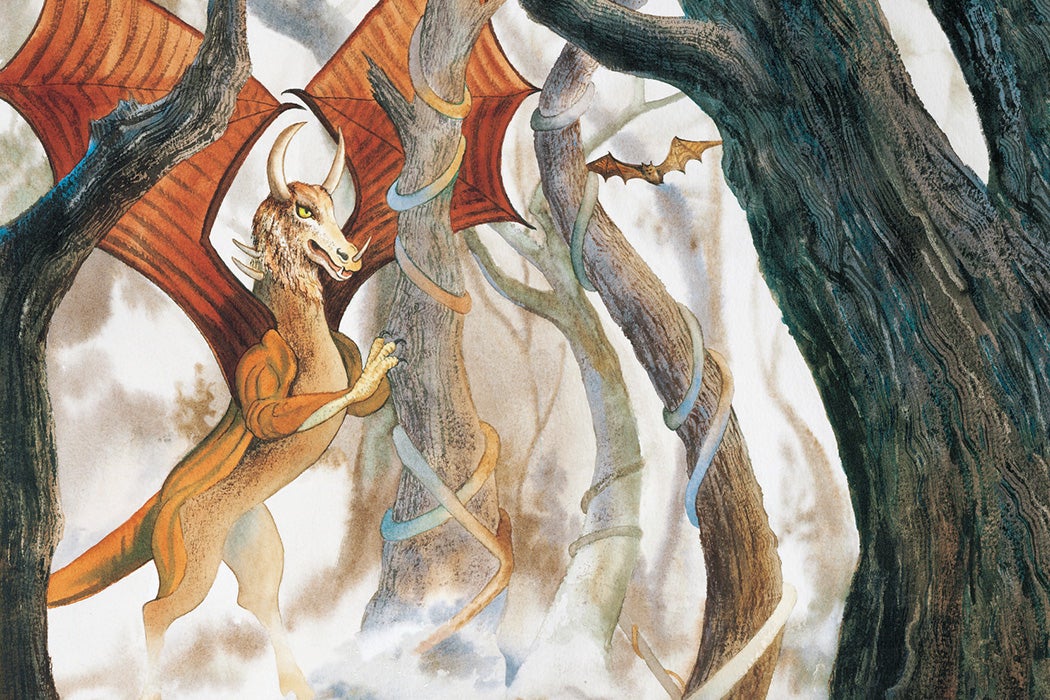In the pinelands of eighteenth-century New Jersey, as the story goes, nothing grew—except children. After one Mother Leeds had given birth twelve times, she found herself pregnant yet again and beseeched God, “If I have a thirteenth child, let it be the devil.” Lo and behold, she delivered a healthy baby and laid it in a cradle near the fireplace. As the clock struck midnight, the newborn sprouted a forked tail, cloven hooves, and wings and flew up and out of the chimney. The Jersey Devil has haunted the pines ever since, or so legend tells us.
Like most Jersey children, I often heard this folktale as a kid, usually around campfires at Halloween. Today I understand it as what the film and media scholar Erin Harrington calls “gynaehorror.” Much like the 1968 film Rosemary’s Baby, it presents the vagina as “site of terror,” dramatizing and criticizing forced birth. Today, New Jersey has some of the most progressive abortion laws in the country. Across the nation, however, access to reproductive healthcare is rapidly eroding as states reinstate antique bans and punish women for miscarriages. With the ever-present possibility of a federal ban, the Jersey Devil is a haunting reminder that when reproductive rights disappear, horror ensues.
The events in the story supposedly took place in the 1700s, but the myth of the Jersey Devil began to circulate in earnest in the nineteenth century, during a period when American reproductive rights were under acute attack by the legal system and the medical establishment and abortion was in the public eye. It first appeared in print in The Atlantic in May 1859, when New York City-based writer W. F. Mayer described the “uncivilized” communities of the Pinelands. (What can I say—Jersey has always had its haters.) One of the destitute locals in the essay, Hannah Butler, mentions a “personal interview” she had with the Jersey Devil while strolling in the woods during a lightning storm. She was not the first to notice him. He had, apparently, been heard “howling and screaming” at night since 1835. One version of the story, recorded in James McCloy and Ray Miller Jr.’s 1976 book The Jersey Devil, posits that this monstrous creature haunted the pinelands after its birth until the 1740s, when an exorcism banished it for one hundred years. In 1840, “he did reappear,” right “on schedule.”
Weekly Newsletter
Set in the Pine Barrens, the sprawling enclave of forest that covers the southern half of the Garden State, the Jersey Devil story takes place amidst an ecosystem known for its difficult to farm sandy soil and swampy iron bogs, from which Revolutionaries once fashioned cannon balls. As Brian Regal and Frank Esposito note in The Secret History of the Jersey Devil, the folktale may have originated in an early colonial religious dispute centered on the polemical almanac-maker and Quaker dissident Daniel Leeds, who lived in New Jersey in the seventeenth and eighteenth centuries. In his 2013 quasi-memoir The Domestic Life of the Jersey Devil, Bill Sprouse suggests that Mother Leeds may be modeled on Deborah Leeds, Daniel’s daughter-in-law, who had twelve children by his son Japhet in an area called “Leeds Point” in the 1730s.
The details of the Jersey Devil morph with every retelling. Sometimes this menace features a dog’s head and pig’s feet; sometimes he’s an eighth child instead of a thirteenth. The story’s emotional crux, however, is consistent: an unwanted pregnancy, a mother’s anger, a curse. It reads as what folklore scholars Joan Radner and Susan Lanser might call a “coded” tale—a story that invites multiple, even contradictory, interpretations to “protect the creator from the dangerous consequences of directly stating particular messages.” A hallmark of feminist folklore, coding allows a tale-teller to convey ideas that are controversial or forbidden by camouflaging morals in ambiguity, ensuring the story reads differently to different audiences. For listeners hostile or unattuned to issues of reproductive care, for example, it’s easy to see the Jersey Devil as a critique of callous mothering, and of the “self-centered, uncaring, unloving mother…who bears the brunt of the [story’s] blame,” write Regal and Esposito.
But that’s a red herring, a misdirection. Though gynaehorror often represents female reproductivity negatively, it can, Harrington notes, function as a “way of exposing misogyny.” Unlike many horror stories that portray what film scholar Barbara Creed terms “the monstrous-feminine”—misogynistic depictions of terrifying, evil women—Mother Leeds elicits empathy. Who would not feel overworked and overwhelmed, with twelve mouths to feed (thirteen if you count her own)? She isn’t even the monster—instead, it’s a lack of access to reproductive options that causes the ensuing problems, as well as the fact that spite and anger function as her only recourse in a desperate situation. The critique of the story falls not on Mother Leeds as a bad mother, but on the circumstances that prevent her from choosing whether to be a mother at all.
Keep in mind that when the story began to circulate in the nineteenth century, women had little say in when they would become pregnant. Reliable oral contraceptives weren’t available until the 1950s (though varieties of condoms had existed since at least the Middle Ages). For married women, abstinence was unreliable, since marital rape remained legal in the United States until the 1970s. In states where slavery was legal, enslaved women had no legal protections against rape at all, and forced birth routinely functioned as a form of gendered and racial violence. This included New Jersey, where slavery began to be gradually abolished in 1804, but enslavement endured in practice for decades longer. Nineteenth-century mothers also often died in childbirth (even today, traumatic births and death in childbirth are still much more common than they should be, especially among Black mothers in the United States, who are less likely to receive adequate care).
With limited means for preventing pregnancies that could result in high-risk childbirths, some nineteenth-century New Jersey women turned to abortion as a means of controlling reproduction. Prior to the 1840s, abortion early in pregnancy was seen as an acceptable means of birth control long tolerated under English common law. Hellebore, pennyroyal, tansy, and other herbs had been used for centuries to treat “blocked menses” and end pregnancies prior to what was referred to as “quickening,” when a fetus first moves (usually sometime between weeks sixteen and twenty-four). During the 1830s and ’40s, newspapers ran ads for “female monthly” and “lunar” pills to end pregnancies and new devices for surgical abortion were invented.
Between 1840 and 1880, however, abortion came under increasing scrutiny across the United States. At the time, white men dominated medical schools, associations, and other bastions of medical practice. In New Jersey, degreed doctors competed for business with self-taught herbalists, such as James Still, whose success in South Jersey as the “Black Doctor of the Pines” provoked the ire of white physicians. As part of a movement to limit medical practice to those with official credentials, university-trained doctors stoked fears about the safety and ethics of abortion, which had long been the domain of female healers, midwives, and other seasoned but unlicensed practitioners of gynecology and obstetrics care. Under pressure from the medical establishment, states quickly moved to outlaw abortions and sanction abortion providers; in 1849, New Jersey instituted its first law against performing an abortion on women “quick with child.”
These early laws tended to punish providers rather than the recipients of abortions. The year before Mayer’s Jersey Devil article was published, for example, an 1858 New Jersey supreme court case, State v. Murphy, ruled that the 1849 law criminalizing abortion could not be applied to patients seeking abortion of their own volition; the judge argued that it was designed instead to sanction whomever had administered care. In newspapers, abortion providers were often slandered as “evil” and devil-like. One 1872 book, Satan in Society, referred to abortion as “a monstrous heresy” (it also claimed, laughably, that the ejaculation “of the seminal fluid…within the vagina” prevents cervical cancer). An illustration from the National Police Gazette depicts the infamous abortion provider Madame Restell as a dour brunette accompanied by a winged, baby-eating devil, who echoes descriptions of the Jersey Devil.

At the same time, the nineteenth-century anti-abortion movement encouraged eugenicist fears that Irish and Italian immigrants would outnumber “native born” Protestant Americans if abortion went unchecked, stoking anti-Catholic sentiment to support its cause. Prior to the 1840s, abortion had been seen predominantly as a means for poor, unmarried women to avoid the crushing stigma of pregnancy out of wedlock. But historians James Mohr and Simone Caron have shown that in the middle of the century, it began to be viewed as a means of limiting family size, especially for well-to-do, “native born” Protestant women who already had children—like, say, Mother Leeds, an early Protestant New Jersey colonist who had, in most versions of the story, already given birth to numerous children when the plot unfolds.
As the tale of the Jersey Devil shocked and entertained listeners in parlors and around dinner tables, abortion was effectively criminalized for the first time in the United States. Due to stigma, legal persecution, and other mechanisms of silence, there are few nineteenth century materials offering perspectives of pregnant women on forced birth. Some of those that do exist are found in the 1858 book The Unwelcome Child by abolitionist and feminist Henry Clarke Wright, who advocated for a wife’s right to abstain from marital sex. Clarke reproduces one woman’s letter that describes the devastating effects of unwanted pregnancy:
No words can express the helplessness, the sense of personal desecration, the despair, which sinks into the heart of woman when forced to submit to maternity under adverse circumstances, and when her own soul rejects it. It is no matter of wonder that abortions are purposely procured.
Like these firsthand accounts, fictions and folklore like the Jersey Devil can offer what literary historian Allan Pasco calls “historical patterns of attitudes [and] behavior.” They fill in the blanks left out of the cold, hard facts of the legal record, giving voice to stories erased by legal history. Today, sharing stories about the desire to end a pregnancy, whether through online #ShoutYourAbortion memes or word of mouth, continues to be a means of voicing dissent. Almost two years after the Dobbs decision jeopardized abortion access across the United States, the message of the Jersey Devil comes through clearly. A society without choice is monstrous—just ask Mother Leeds.
Support JSTOR Daily! Join our membership program on Patreon today.







